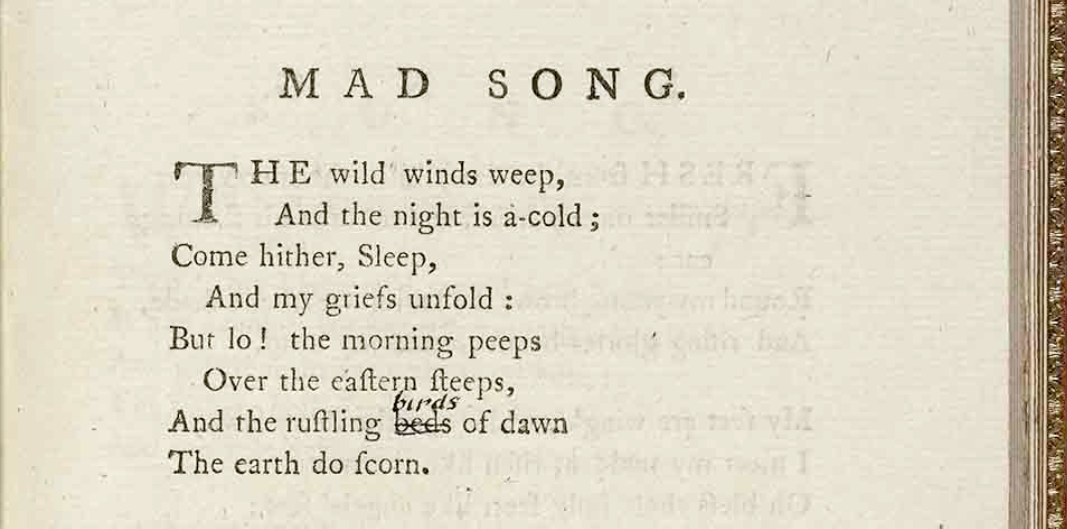Always interested in the intersections of language and visual representation, in this post I examine the variety of bodies—and range of bodily contortions—encompassed under the single search term “lunging” as a continuation of my series on WBA text tags (see my earlier posts about textual tagging broadly and “streams of gore”).
The comprehensive list of search terms used to tag images in the WBA includes a variety of categories relevant for describing figures, including figure type (blacksmith, demon, queen), specific character (Athena, Cerberus, Judas), positions (facing left, leg raised, twisted), and physical attributes (long hair, nude, young). Often, such descriptors are relatively straightforward to identify based on either the compositional evidence or the literary context. However, in our tagging process we aim to communicate as much information as possible about a figure, including what the depicted figure is doing. We currently have 136 terms to describe action. Most are phrased as present participles and range from the mundane (bending forward, walking, standing) to the more, shall we say, Blakean (petrifying, howling, cannibalism, weaving). And much like the dreaded “action verb” category in my family’s favorite holiday game, Pictionary, actions are frequently the most difficult to both interpret and tag according to a set list of terms.
When searched, the term “lunging,” for example, appears at least once in 19 discrete works that span the majority of Blake’s oeuvre and thus demonstrate the variety possible within a single textual tag. Several results from Blake’s illuminated books illustrate that he repeatedly depicts a nude lunging male figure seen from behind. The lunging figures in Urizen and Jerusalem are particularly muscular—perhaps an homage to Michelangelo’s similarly strapping figures—and all appear to labor strenuously, even violently.
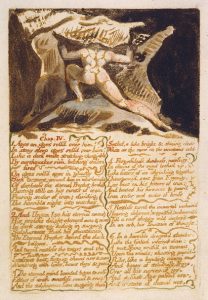
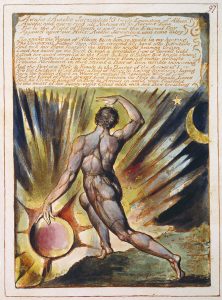
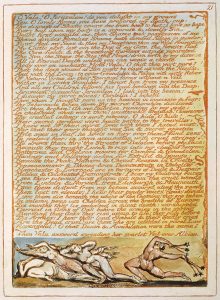
From left: Urizen, copy A, object 13; Jerusalem, copy E, objects 97 and 21.
A similar connection between lunging figures and violence is clear in two of Blake’s engravings of John Flaxman’s illustrations for The Works Days and Theogony of Hesiod, in which we see combative, lunging women—here, the Furies—as well as men. As commercial engraving commissions, the Hesiod compositions attest to the broader interest in the lunge as an action, both contemporaneously by Flaxman and historically in the Greek and Etruscan vase painting that inspired Flaxman.
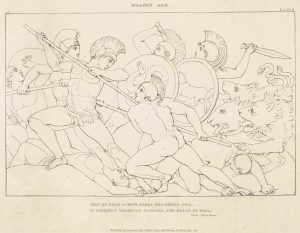
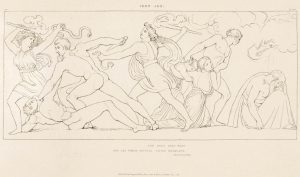
From left: Blake’s engravings of John Flaxman’s The Works Days and Theogony of Hesiod, “Brazen Age,” object 12, and “Iron Age,” object 14.
In contrast, the lunging figures in the Marriage (seen in two details below) are much smaller, as they are interlinear figures. Although the lunging figure in object 6, directly below the first letter of “Memorable,” is also seen from behind and may be nude and male(?), the figure’s body type and position appears, here, quite lithe and graceful. Moreover, the figure hovers directly above the word “walking,” and the visual/textual pairing thus provides a fuller representation of the narrated action. The second example from Marriage further underscores the breadth of the term as the one lunging is not a human figure but rather a horse, which is also tagged as “leaping.”

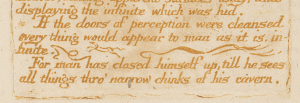
From top: Marriage of Heaven and Hell, copy A, object 6 and 14.
Following somewhat appropriately, we also find a lunging animal-human hybrid (an enchanted follower of Comus) in the center of Blake’s illustration of Milton’s “Comus.” Yet whereas the bodily movement in the previous image attests to the encompassing celebratory atmosphere, similarly exaggerated lunges in Blake’s illustration of Robert Blair’s “The Grave” underscore the drama of the death and despair in the composition. Indeed, the complementary, active positions of the top figure (likely the spirit of the dead man below) lunging left out the window and the middle female figure lunging right toward the dead man below create a stark compositional contrast with the stillness of both the dead body and the standing figure at left.
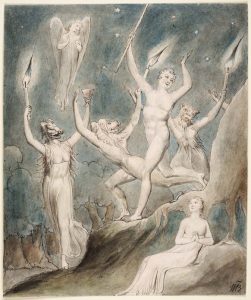
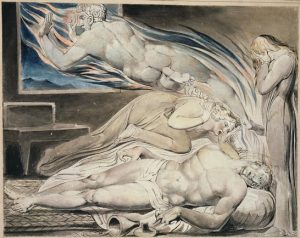
From left: Illustrations to Milton’s “Comus,” Thomas Set, “Comus with his Revellers,” object 1; Illustrations to Robert Blair’s “The Grave,” “Death of the Strong Wicked Man,” object 8.
With such an investigation of a single action term—something as simple as “lunging”—we can begin to think through Blake’s oeuvre in new ways. In particular, we can examine the variety within many depictions of a movement with attention to repeated motifs, such as the depiction of male lunging figures from behind or the intensely expressive faces that accompany female figure who lunge, to continue interrogating and identifying new connections within Blake’s visual imaginary.


